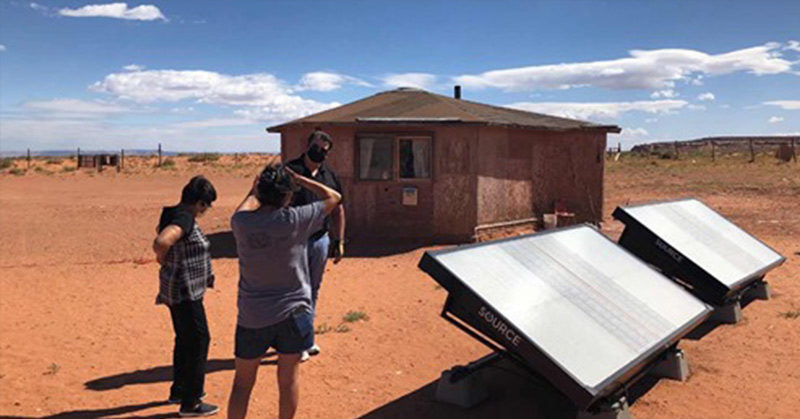Imagine how different your life would be if you didn’t have access to clean drinking water? This nightmare is a reality for the Navajo people, and has been for many years. A new type of solar panels, however, might just be the solution they’ve always needed. These solar panels are able to pull water right out of thin air.
Solar Panels Pulls Water Out of the Atmosphere
This air-to-water technology is being piloted for 15 Navajo families who traditionally have to travel for hours just to get water. Managed by Navajo Power, Public Benefit Corporation, and Arizona-based Zero Mass Water, these families are able to turn on their taps and have drinkable water for the first time ever. (1)
The project is funded by a grant provided by the Unreasonable Group and Barclays Bank whose goal is to end the problem of clean water access to the Navajo Nation. This issue, which has existed for years, has been especially apparent during the COVID-19 crisis. (1)
How it Works
Water vapor is captured directly from the air and turned into actual potable water. It is done using Source hydropanels that are powered by off-grid solar energy. These panels have fans that pull in the air and then send it through a hygroscopic. (2)
Here, the trapped water vapor is extracted and condensed into actual liquid water. The collected water is mineralized for taste and can then be sent through taps right into people’s homes. (2)
Each panel is connected to a cloud-based network to be monitored for quality and performance. (2)
Not the First Source Installment
Source hydropanels are not brand-new: they already supply clean drinking water to tens of thousands of people in 45 different countries. They do this by partnering with governments, corporations, and development organizations. (2)
Source hydropanels can be installed at small residential homes, on the roofs of schools and community centers, and as “water farms” next to whole communities. (2)
How Effective Are Source Panels?
The hydropanels use both solar power and a small battery to retrieve the water from the atmosphere. They can last for 15 years, and store water in case of a cloudy day with much sun. (1)
“A standard, two-panel array, produces 4-10 liters of water each day, and has 60 liters of storage capacity,” said Cody Frisen, CEO of Zero Mass Water. (1)
What’s better is the quality of that water, which is far better than the standards of the countries in which they are being used. (1)
“There are thousands of homes without water and this is a more cost-effective approach to getting clean water to these families. While our focus as a company is the development of large clean energy projects, our commitment to the well-being of Navajo communities is our north star, and we want to do everything we can to help the Nation mitigate the threats brought by the pandemic.” said Clara Pratte, president of Navajo Power. (1)
A Sustainable Solution
The potential of Source hydropanels is not just for the Navajo community, but for all communities living in remote areas. (2) They empower these residents to have their own means to clean drinking and cooking water that is (2):
- Secure
- Resilient
- Cost-effective
- Accessible
- Sustainable
They are cheaper and more sustainable than building pipes and compliment existing systems like wells and rainwater collection. (2)
Zero Mass Water and Navajo power have come together to suggest that a portion of the CARES Act funding go to the mass deployment of these Source Hydropanel systems to communities in need. Navajo Power themselves has already distributed hundreds of thousands of dollars in aid and help to communities due to COVID-19. They have supplied in-need communities with items such as PPE and firewood, among others. (1)
Keep Reading: First Floating Ocean Hybrid Platform Can Generate Power From Waves, Wind And Solar

